Fair trading
Brian Sewell
To any independent observer the continning dispute over the buyer's Premium between representatives of the art and antiques trade on the one hand and Christie's and Sotheby's on the other, must be a puzzling and disturbing spectacle. If there was ever a suitable moment to oppose the premium, then it must have been at the time of its imposition in 1975 — it might not then have seemed decorous to the leaders of the British Antique Dealers Association (BADA) and the Society of London Art Dealers (SLAD) to picket the doors of offending auction houses, but a boycott of sales would certainly have forced them to reconsider the impost. Six years later the dealers chose to fight on the grounds of collusion between Christie's and Sotheby's, but withdrew their case at the last moment, apparently convinced that quiet discussion would settle matters to everyone's satisfaction. If that could be so, then the time for such discussion was six Years ago, without the damaging acrimony that has built up in this period, and without the waste of £150,000 in legal fees.
The charge of collusion is absurd and irrelevant. The terms and conditions of both the major auctioneers have for decades differed only in minor details, and since the early Sixties they have organised their schedules so that neither sales nor interests conflict — over such matters the trade has never cried collusion, for they are largely to the trade's advantage. It is absurd therefore to imagine that on such an important point as the imposition of a premium they should be out of line, whether or not there was any discussion of the matter. No one complains of collusion when all the banks re-align their interest rates, or all oil companies raise their petrol prices within hours of each other. There may, of course, be an element of spite in the accusation, for Sotheby's in some of their activities rival the trade with outright purchase, part share and guaranteed sales — though Christie's have never engaged in these practices.
The trade is expecting some reduction in the buyer's premium from 10 per cent; what it has never revealed is that with its introduction Christie's and Sotheby's made a series of concessions to trade vendors — at both the selling commission was reduced from 10 per cent to 6 per cent, and the introductory commission doubled from 2 per cent to 4 per cent; Christie's dropped the buying-in commission on unsold lots, did not charge for illustrations that may cost as much as £200 to print in their catalogues, and on important sales the vendor's commission has been negotiable down to almost nothing. Sotheby's have been less generous in detail to the trade, but their terms for commission and illustration have always been negotiable.
The British trade has really not done so badly overall. The great weakness of its case is that European dealers have been paying a buyer's premium to European auction houses for decades, and their buying in London has not been in the least affected by its imposition here: if London dealers have wished to compete with their continental brethren, then they have had to match their bidding — and as most dealers behave at auction as though they are playing poker, their claim that their bidding is reduced by the amount of the premium is nonsense — watch them in the sale-room in vicious competition with each other and it will be obvious that often it is victory that matters and not the cost.
Christie's and Sotheby's charges compare favourably with all continental auctioneers, the worst of whose charges amount to 35 per cent, made up of 15 per cent from the vendor and 20 per cent from the buyer. The combined commissions to the London houses amount to an average of less than 15 per cent on each transaction; this makes nonsense of accusation of enormous profit — look again at the trade, where asking prices of 120 per cent above auction levels are the norm.
The buyer's premium guarantees the auction houses 10 per cent in the event of a successful sale: if that premium is to be whit tied away, then it will have to be recovered from the vendor, no doubt by returning to the old system of a scale of commission charges with higher rates on lower prices, and the cost of illustration and advertising levied through additional charges. Year after year at Christie's the number of transactions carried out for the trade has been within spitting distance of 80 per cent of the total, and it should be clear to members of BADA and SLAD that it is largely they who will suffer any increases in vendor's commission: inevitably it is the small traders who will bear most of such increases, and the Bond Street boys least.
One sad by-product of the dispute is that the auction houses will seem to the public in some way disreputable, yet they are the foundation upon which the London art trade is based. Dealers come and go, and they change their ethical standpoint to suit the circumstances of the day, but the auction houses remain for centuries, with a clear responsibility to the vendors. Christie's and Sotheby's command a level of expertise often far above that of dealers, and their profit is directly related to the benefit of their clients; private vendors unaccustomed to the market place are much safer in their hands than in those of the trade, for there are few dealers who will pay in cold blood (and it is often very cold indeed) more than a tittle of what they will pay in the heat of competition provided by the auction houses.


































 Previous page
Previous page